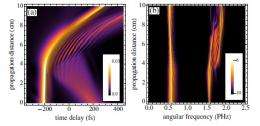May 5, 2011 feature
Proposal for optical transistor uses light to control light

(PhysOrg.com) -- By using one light pulse to control another, researchers have proposed a design for an optical transistor that fulfills the most challenging criteria set forth in a study last year. An optical transistor has long been sought by physicists because it could be used for optical computing, in which photons rather than electrons are used to perform digital computations.
The researchers, Ayhan Demircan and Shalva Amiranashvili from the Weierstrass Institute for Applied Analysis and Stochastics in Berlin, and Günter Steinmeyer from the Max Born Institute in Berlin, have published their study in a recent issue of Physical Review Letters. It is the first proposal that meets all the criteria for a useful all-optical transistor that were laid out in a previous paper in Nature Photonics by D.A.B. Miller, et al.
“What we would like to do is to ‘switch’ an optical soliton (signal pulse) from one intensity to another,” the researchers told PhysOrg.com. “The usual ‘mechanical’ way to do so is to change the properties of the fiber. More elegant ‘all-optical switching’ uses an additional pulse (control pulse). This should lead to some kind of ‘optical circuit’ which is operated completely by light.”
As the scientists explained, when optical pulses collide, they typically do not change very much. Therefore, the control pulse usually has to be very large for it to have any effect on the signal pulse.
Here, the scientists have described a way to use a weak dispersive pulse to control a strong signal pulse, where the dispersive control pulse is seven times weaker than the signal pulse. In the new concept, both pulses travel in the same direction in a non-linear medium at different frequencies but at almost identical velocities. If one pulse can come from behind and catch up to the other, the pulses can interact.
Interestingly, from the perspective of the control pulse, the signal pulse looks like an optical event horizon similar to that of a white hole, which marks the boundary at which matter on the outside cannot enter. In the proposed concept, the control pulse and the signal pulse are temporarily locked in an optical event horizon for a long enough time to allow the control pulse to modify the properties of the signal pulse. For example, by changing the signal pulse’s intensity, frequency, speed or shape, the control pulse can effectively “switch” the signal pulse as part of a transistor.
“In short: a signal pulse can exchange energy with a control pulse if the latter is affected by the event horizon created by the former,” the researchers wrote. “Whatever that event horizon may possibly be, the energy transfer indeed occurs if both pulses have very close velocities.”
The signal pulse could also be switched repeatedly, making the scheme practical.
“The most important thing about our all-optical switching is that one may use several control pulses and thus switch the signal pulse many times, either increasing or decreasing its intensity,” the researchers wrote. “The signal pulse may then serve as a key element for an all-optical circuit.”
This novel concept for an all-optical transistor could overcome some of the challenges facing the design of these transistors, specifically cascadability and fan-out. Because the strong pulse does not dispersively spread or break up into multiple pulses, the output can be used for the input of the next switching action, which makes the switching scheme cascadable. In addition, the new design has the ability for fan-out, meaning that the output can be used for multiple inputs.
Since no all-optical transistor has been demonstrated that, among other things, can be cascaded in several stages, the new concept takes an important step in developing a practical optical transistor. Because photons travel much faster than electrons, optical transistors should have much faster switching speeds than current transistors.
More information: A. Demircan, et al. Controlling Light by Light with an Optical Event Horizon. Physical Review Letters 106, 163901 (2011). DOI: 10.1103/PhysRevLett.106.163901
Copyright 2011 PhysOrg.com.
All rights reserved. This material may not be published, broadcast, rewritten or redistributed in whole or part without the express written permission of PhysOrg.com.




















